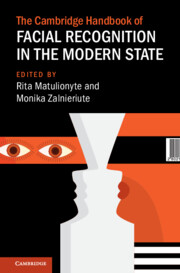
-
- You have access
- Open access
- Cited by 1
-
Cited byCrossref Citations
This Book has been cited by the following publications. This list is generated based on data provided by Crossref.
Lynch, Nessa 2024. Facial Recognition Technology in Policing and Security—Case Studies in Regulation. Laws, Vol. 13, Issue. 3, p. 35.
- Publisher:
- Cambridge University Press
- Online publication date:
- March 2024
- Print publication year:
- 2024
- Online ISBN:
- 9781009321211
- Creative Commons:
-
This content is Open Access and distributed under the terms of the Creative Commons Attribution licence CC-BY-NC-ND 4.0 https://creativecommons.org/creativelicenses
- Series:
- Cambridge Law Handbooks
- Subjects:
- Law: General Interest, Computer Science, Computing and Society, Law, Law and technology, science, communication
- Collection:
- Cambridge Law Handbooks


